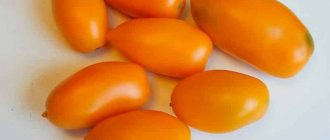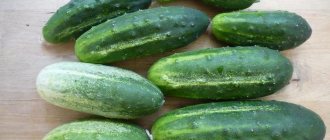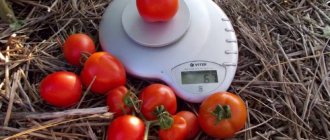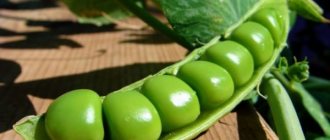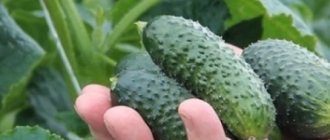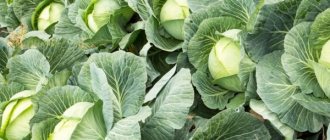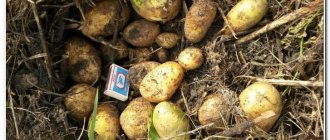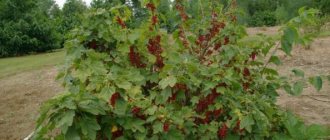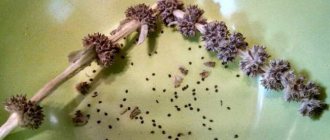Container gardening
Cilantro or coriander (Coriandrum sativum) is a healthy crop that is actively used in food as a spicy seasoning. This useful herb is offered by various supermarkets or vegetable markets, but growing your own herbs is becoming increasingly popular. This not only allows you to get a fresh harvest, but also significantly saves your budget. In this article, we propose to study how cilantro is grown on a windowsill, consider the intricacies of this process, as well as popular varieties of the crop.
- 1 What are the benefits of coriander?
- 2 Where to start growing cilantro from seeds on a windowsill?
- 3 How to grow cilantro from seeds on a windowsill in stages 3.1 Features of watering and fertilizing
- 3.2 Treatment for diseases and pests of cilantro on the balcony
Varieties of cilantro for growing on a windowsill
Cilantro is popularly known as cilantro, kolyandra, kishnets or Chinese parsley. Growing coriander from seeds on a windowsill is done by people who love fresh herbs all year round. In addition, the herbaceous plant is a natural aphrodisiac.
Before planting an aromatic herb, you should choose the most suitable variety for growing:
| Variety | Characteristic |
| "Alekseevsky" | Grows up to 90 cm. The leaves are smooth with umbrella-shaped inflorescences. |
| "Borodino" | Technical ripeness occurs in 45 days. The variety is classified as mid-season. |
| "Lovely" | Ripens at 35 days. The bushes grow small, up to only 50 cm in height. |
| "Vanguard" | High-yielding variety. Used in cooking as a spice or herb. |
| "Kin-Dza-Dza" | Medium yield cilantro. It has erect stems with a small number of branches. |
| "Ray" | The plant reaches 50 cm. Contains a significant amount of vegetable protein. |
| "Chico" | Mid-season cilantro variety. It grows in a maximum of 45 days. It is distinguished by fluffy leaves. The stems grow up to 55-60 cm. |
Growing cilantro from seeds on a windowsill will take approximately 1-1.5 months. Unlike sowing in open ground in the spring, you can plant plant seeds at home in the fall or winter.
Harvesting
Unlike collecting cilantro from garden beds, plants from the windowsill are never pruned at the root. It is necessary to leave 1 cm in length of the stems. Then the cilantro leaves will begin to grow again.
Coriander leaves are cut off, the length of which is at least 15-20 cm. Small central leaves are left to continue the growth of greenery.
The peculiarity of cilantro is that it dies very quickly. To avoid being left without coriander, you should plant new seeds every 2-3 weeks. Then you will provide yourself with cilantro for a long period.
Coriander seeds are harvested when they are easily separated by hand. Most often their color changes to light brown. Dry the cilantro thoroughly.
What you need to grow cilantro
Not only an experienced summer resident, but also a novice amateur can grow seedlings at home. Before sowing seeds, it is better to prepare all the necessary equipment in advance.
To grow cilantro at home you will need:
- Garden or purchased land;
- Coriander seeds;
- Container for seedlings;
- Mineral fertilizers;
When purchasing seed, it is important to pay attention to the packaging date. Cilantro seeds do not improve with age, so choose seeds that are no more than a year old. The purchase will not take much time and will cost 25-40 rubles per package.
Choosing the optimal place in the house
Growing cilantro at home requires choosing a well-lit place. An aromatic spice native to the Mediterranean, accustomed to warm climates. Therefore, it is recommended to place seedlings on windows on the south or east sides. In this case, the plant will receive the maximum amount of light per day. In the absence of such conditions, it is sufficient to use an artificial lighting lamp.
If the crop does not have enough sunlight, the greens will grow slowly. In this case, the stems will be thin and frail, with sparse leaves at the top. For vigorous growth, cilantro requires rays of orange-red and violet-blue hues. Phytolamps provide the necessary lighting without overheating the greens.
Although coriander prefers to grow in dry, warm climates, it tolerates low temperatures well.
Selection and preparation of containers
The choice of a suitable container depends on the planned amount of greenery. If this is your first experiment with planting coriander, then you can get by with a small flower pot. If you plan to harvest a rich harvest, then choose spacious boxes or trays. Their depth should be at least 25-30 centimeters.
Plastic container
Expanded clay
Don’t worry if you don’t have suitable containers at home and don’t want to spend extra money. Take a plastic bottle as a base, cut off the neck and make holes in the bottom. Cilantro will grow unpretentiously both in a clay pot and in a plastic container. This is a matter of aesthetics and personal taste.
Helpful information
Daria Vorontsova
Amateur gardener. He is interested in growing various greens at home.
Cilantro does not tolerate transplantation, so it is better to choose a container of the appropriate size right away.
Whatever the container for growing coriander from seeds at home, holes for water drainage are required. Cilantro loves moist soil, but does not tolerate stagnation and waterlogged soil.
Soil selection
To grow fragrant greens in an apartment in winter, both purchased substrate and soil from the garden are suitable. Often these two types of soil are combined, resulting in a fertile base for plants.
Priming
Soil in a container
You can purchase ready-made soil at a gardening store. Usually used universal for all types of plants. In addition, you can prepare nutritious soil yourself.
Required components:
- Humus;
- Sand;
- Turf land;
- Ash.
A drainage base made of sand, pebbles or expanded clay is placed on the base of the pot.
Calcining the soil in the oven
Wood ash
Soil from a summer cottage can hide pest larvae. Before planting, the soil is sifted and calcined in the oven. Adding wood ash helps disinfect the soil.
Preparing seeds for planting
It is possible to grow cilantro on a windowsill in winter only from seeds. Moreover, their germination rate decreases after 2 years. To get a year-round harvest of greens, it is better to sow seeds at different times, with an interval of 21-30 days. The sowing process should begin with the preliminary preparation of coriander seeds.
Preparatory procedures:
- The seeds are pre-soaked in warm water for 2-4 hours. This is required to swell the shell and increase the chances of germination;
- In loose soil, excavations of up to 2 centimeters are formed at intervals of 5-6 centimeters;
- The seeds are carefully sprinkled with a loose layer of soil and watered with a syringe;
- For better germination, containers are covered with a bag or film. Place in the warmest corner of the apartment;
- After the first shoots appear, the film is removed.
Plant cilantro sparsely, providing each plant with free space of up to 6 centimeters.
After the first shoots have appeared, the cilantro is placed on the windowsill. You can enjoy the first fresh leaves after 3 weeks.
Creating the necessary conditions: air humidity, lighting and temperature
Cilantro is an undemanding crop to the surrounding climate. However, when creating the most comfortable conditions, the plant pleases with lush leaves and a spicy aroma.
Greenery prefers well-lit areas of the house, so pots with seedlings are placed on the windowsill. In winter, when daylight hours are short, additional lamps are installed. With a lack of light, the plant stretches, but at the same time it is frail. It is almost impossible to achieve lush greenery without proper lighting. The daily norm for cilantro is 6-9 hours.
Cilantro tolerates low temperatures indoors well in winter. Even at +6-10°C the plant will not die. However, in this case, you should not count on the rapid growth of coriander. A sickly appearance of seedlings with lifeless sparse leaves is a sign of lack of heat. The optimal temperature in the room is considered to be +18-25°C.
Maintaining moisture is no less important for the normal development of stems and green mass. There are no difficulties here; it is enough to maintain a balance between high humidity and dry air. To do this, the room is systematically ventilated, ensuring normal air circulation.
ugoloktswetowoda
_lillishop_
ugoloktswetowoda
natalia_boucha
efremova278
katerina_toropseva
Useful tips
In addition to the generally accepted rules for growing cilantro on a windowsill, summer residents know some secrets and tricks. This allows you to get high-quality results faster and without much effort. For example:
- Cilantro should be sown continuously at monthly intervals. This way, fresh herbs will be on the table all year long.
- You can reuse the soil by adding a little compost and disinfecting it in any convenient way.
- Do not dry cilantro greens. It will not please you with either taste or smell. It is better to dry the seeds and grind them into powder before use.
- Add coriander powder to dishes before the end of cooking so that it does not lose its aroma.
- When cilantro blooms, the greenery smells like bugs. Then this smell changes to citrus. You just need to wait.
- It is recommended to plant several varieties of cilantro at once. They behave differently under the same conditions. The taste will be more varied, you can choose the variety you like for further cultivation.
- Pinch flower stalks in a timely manner to prevent the leaves from developing an unpleasant odor.
Another tip is that you should not sow cilantro in the same pot with other herbs. She doesn't really like her neighbors.
Cilantro should be grown separately from other herbs so as not to inhibit the plant.
Care: watering and fertilizing
The crop has been planted and the first shoots have already sprouted. The important stage of caring for the plant begins. This includes thinning, fertilizing and watering measures.
Cilantro loves abundant watering, but stagnation of water in the pot is unacceptable. Excessively moist soil rots, causing pathogens and mold to grow in it. The root system soon dies.
How to water:
- Coriander should be watered generously, draining the remaining water from the pan;
- You can moisten green leaves using a spray bottle;
- Water for irrigation is used at room temperature;
- Do not allow the soil to dry out;
- During the active growth phase, watering is increased and reduced in winter.
Coriander will grow poorly both in too dry soil and in a waterlogged substrate.
It is better to feed the plant after the formation of the first rosettes, when the sprouts have become stronger. Cilantro prefers mineral supplements. Fertilize greens 2-4 times a month.
Is cilantro grown on a windowsill better than store-bought cilantro?
Yes, more fragrant. No difference.
Harm of coriander
Almost everyone can eat this spicy herb; there are no contraindications. It can only cause harm if used unrestrictedly. Due to excessive use, the surface of the skin may turn red, sometimes rashes and swelling may appear on it. In some cases, the person will feel sick. All these signs indicate the occurrence of an allergic reaction to the product being consumed.
In addition to allergic manifestations, abuse leads to:
- insomnia appears;
- memory deteriorates;
- menstruation is disrupted;
- bleeding increases;
- the blood becomes thicker;
- blood clots form.
Diseases and pests
Coriander grown indoors is less likely to get sick or be attacked by pests. However, failure to follow the rules of care has negative consequences.
| Disease | How it manifests itself |
| Ramulariasis | Fungal disease. The leaves are dotted with brown spots that look like rust. Occurs due to increased air humidity. |
| Powdery mildew | The leaves and stems are covered with a white coating, which becomes denser over time. Occurs if the plant grows in a room with dry and warm air. An excess of nitrogenous fertilizers is one of the possible reasons. |
| Rust | The causative agent is a fungus. Red vesicles appear on the leaves, containing fungal spores. At home, plants rarely get sick. |
Ramulariasis
Rust
Powdery mildew
The specific smell of cilantro repels most parasites. However, among the detractors there are gourmets who are not averse to eating succulent leaves.
Main insect pests:
- Fall armyworm caterpillars;
- Striped bug;
- seed eater;
- Wireworm.
seed eater
Wireworm
Striped bug
Cutworm
At home, greens are not susceptible to attack by parasites. They can be introduced through untreated soil from a garden plot.
Storage
Store fresh cilantro in the freezer, cut the leaves and freeze them. Then add it to the finished dish. If it is not possible to freeze coriander, you can dry it. Chop the cilantro and place in a dry container with a tight lid.
Ripe seeds are dried and stored whole. This is how cilantro retains most of the substances for which it is valued. Before use, coriander is crushed.
